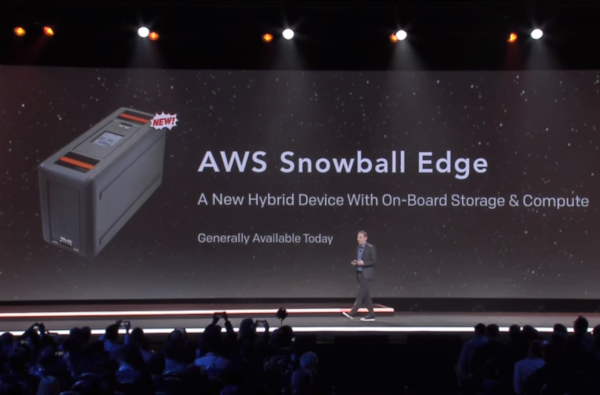 CLOUD
CLOUD
 CLOUD
CLOUD
 CLOUD
CLOUD
Following a recent report that Amazon Web Services Inc. could launch new network switches to target the data center hardware market, the cloud giant is taking a new step in that direction.
AWS today announced the availability of EC2 compute instances — virtual servers in Amazon’s Elastic Compute Cloud service — for its Snowball Edge appliance. The system combines a 1.8-gigahertz Intel Xeon processor and 100 terabytes of storage in a portable, ruggedized chassis that can be transported over long distances.
At the same time, Amazon also unveiled a batch of new, high-powered Z1d instances for its cloud mothership, or services running in its public cloud data centers, that it claims are faster than anything available on any public cloud to date.
Snowball Edge is part of an appliance line that AWS had originally created for moving data. In particular, the goal was to make it easier for customers to migrate large volumes of information from their in-house infrastructure to the cloud. Snowball Edge introduced the ability to create object storage pools and run Lambda automated compute functions for handling simple tasks while the system is still on a company’s premises.
The new Snowball instances significantly expand the range of workloads that companies can deploy on the system. Snowball Edge now offers a choice of six EC2 instances that provide up to 16 virtual central processing units, with storage capacities ranging from 1 to 32 gigabytes. The nodes on a single system can use a maximum of 24 virtual CPUs and 32 GB of memory.
AWS is targeting companies such as manufacturers that require the ability to process important data on-premises. In plants and certain other environments, information often can’t be reliably sent to the cloud for analysis because of slow internet connectivity.
According to AWS, companies may manage their Snowball Edge deployments with the same tools they use for their cloud-based EC2 instances. This native integration should give the system an edge over other appliances that target remote edge environments. Additionally, today’s update may make AWS more competitive against Microsoft Corp., which offers a platform called Azure Stack that enables companies to run cloud applications on-premises.
Analyst Holger Mueller of Constellation Research Inc. told SiliconANGLE the Snowball instances are a smart idea by Amazon, because for all the talk of moving to the cloud, the realpolitik of information technology still requires enormous compute and storage capacity onsite.
“Data security reasons, post network performance, and a general mistrust of not having machines on site are the key drivers for having on-premises capabilities in 2018,” Mueller said. “AWS’ new Snowflake instances are another step and commitment by the vendor, enabling more next-generation application use cases on-premises.”
Amazon is also boosting its competitiveness in the public cloud with the launch of the new EC2 Z1d instances, which are optimized for electronic design automation, semiconductor design and relational database workloads, as well as some other kinds of high-performance computing such as those used in financial services. Amazon Chief Technology Officer Werner Vogels introduced the new instance types at the AWS Summit in New York Tuesday, saying they’re the “fastest in the public cloud” and will be made available in coming weeks.
In a separate blog post, Amazon Chief Evangelist Jeff Barr introduced further instance types in the form of the R5 and R5d, which are designed to provide better price-per-gigabyte performance for in-memory caches, database and big data. The R5 offers memory optimized instances with up to 50 percent more vCPUs and 60 percent more memory than Amazon’s older R4 instances, while the R5d memory optimized instances are additionally equipped with local NVMe storage.
Mueller said the new instance types are a response to AWS’ enterprise customers’ demands for more flexible computing and storage options.
“It’s good to see infrastructure-as-a-service vendors like AWS improving the instance variety and striving for more powerful options,” Mueller said. “For example, the improved R-series is going to be an interesting option for customers using SAP’s Hana in-memory based applications. But equally other databases will benefit from larger machines and footprints.”
Barr said all three new EC2 instance types were made possible by its Nitro system, which is a collection of building blocks that can be assembled in many different ways, providing greater flexibility to design and rapidly deliver instances with a broader range of compute, storage, memory and networking options.
Amazon said the Snowball Edge instances are available from $500 per 10 days of use, while long-term plans start at $15,330 per year. Pricing for the Z1d, R5 and R5d instances isn’t yet available.
Mark Ryland, director of AWS’ Office of the Chief Information Security Officer, provided some details of Snowball Edge, including the security measures it uses, in an interview on theCUBE, SiliconANGLE’s livestreaming studio, from AWS Summit:
Support our mission to keep content open and free by engaging with theCUBE community. Join theCUBE’s Alumni Trust Network, where technology leaders connect, share intelligence and create opportunities.
Founded by tech visionaries John Furrier and Dave Vellante, SiliconANGLE Media has built a dynamic ecosystem of industry-leading digital media brands that reach 15+ million elite tech professionals. Our new proprietary theCUBE AI Video Cloud is breaking ground in audience interaction, leveraging theCUBEai.com neural network to help technology companies make data-driven decisions and stay at the forefront of industry conversations.